© Crown copyright 2023
This information is licensed under the Open Government Licence v3.0. To view this licence, visit www.nationalarchives.gov.uk/doc/open-government-licence/
Any enquiries regarding this publication should be sent to nnss@apha.gov.uk
Contents
- Contents
- Ministerial foreword
- Chapter 1: Introduction and scope
- Chapter 2: Aim and strategic outcomes
- Chapter 3: Prevention
- Chapter 4: Surveillance, early detection, monitoring and rapid response
- Chapter 5: Long term management and control
- Chapter 6: Prioritisation and risk analysis
- Chapter 7: Evidence
- Chapter 8: Building awareness and understanding
- Chapter 9: Cross-cutting provisions
- Chapter 10: Collaboration and partnership
- Chapter 11: Implementation and review
- Annex 1: Governance for the GB Strategy
- Annex 2: Glossary of key terms
Ministerial foreword
Invasive Non-Native Species (INNS) threaten our biodiversity, our ecosystems, and our economy. They are one of the top five drivers of biodiversity loss globally[1]. They threaten our ability to meet our wider environmental targets and to respond to the climate and nature emergencies we face, and cost the Great Britain economy nearly £1.9 billion pa[2] in direct costs.
A refreshed strategy is needed to tackle these species and prevent them from derailing our wider environmental ambitions. At a global level, the UK has played a key role in negotiating a new Global Biodiversity Framework at COP15 of the Convention on Biological Diversity (CBD). This new framework represents a historic opportunity to drive ambitious global action over the next decade, including a specific target on invasive alien species[3].
The UK, Scottish and Welsh Governments have all committed to protect 30% of land and ocean globally by 2030, where the effective management of INNS, as set out in this strategy, plays an important part in making sure that the required ecological status of protected areas is achieved. Similarly, managing INNS is also an important part of ongoing efforts to secure effective productive land use and food security. As part of the careful planning of tree planting to meet the United Kingdom’s legally binding target to achieve net zero greenhouse gas emissions by 2050, it will continue to be important to plant the right tree in the right place and find better ways of protecting trees from INNS. The UK Government has also set a world leading target to halt the decline in species by 2030, under the Environment Act 2021, and there are similar nature restoration targets being developed in Scotland and considered in Wales. Tackling the threat posed by INNS to native biodiversity will be key to meeting these targets and will drive action to recover native species, such as the red squirrel.
Since the last strategy was published, public awareness over the urgent need to prioritise biodiversity and green recovery has increased. This strategy is a key part of ensuring Great Britain continues to demonstrate, both nationally and internationally, that we take the threat posed by INNS seriously and are prepared to take concerted action against it. We will continue to work closely with Northern Ireland and our international partners.
We know what we need to do and how to do it, with robust preventative action and the management of high-risk pathways at the heart of our approach. The refreshed Strategy builds on the successes of previous years and sets out a series of ambitious aims to guide our strong partnership of government, voluntary organisations, NGOs, researchers, businesses and the public into 2030.



Lord Richard Benyon, Minister of State for Biosecurity, Marine and Rural Affairs, DEFRA
Lesley Griffiths AM, Minister for Rural Affairs and North Wales, and Trefnydd, Welsh Government
Lorna Slater MSP, Minister for Green Skills, Circular Economy and Biodiversity, Scottish Government
Chapter 1: Introduction and scope
The Great Britain (GB) Invasive Non-native Species (INNS) Strategy was first published in 2008 (2008 Strategy) and updated in 2015 (2015 Strategy). This refreshed Strategy sets out an ambitious platform for future work on INNS, taking account of the recommendations of a review undertaken in 2020/21[4].
The Strategy covers INNS in the terrestrial, freshwater, and marine environments and also species native to one part of a country that become invasive in areas outside their natural range. The term ‘non-native species’ (NNS) is used throughout this document and is the equivalent of ‘alien species’ (as used by the Convention on Biological Diversity[5] (CBD)) and ‘non-indigenous species’ (as used by the OSPAR Commission[6] and the UK Marine Strategy[7]); it refers to a species intentionally or unintentionally introduced outside its native range by human actions. An ‘invasive non-native species’ (INNS)[8] is any non-native animal or plant that has the ability to spread causing damage to the environment, the economy, our health, or the way we live.
The scope of the Strategy covers all NNS of flora and fauna with the exception of genetically modified organisms (GMOs), bacteria and viruses. Its full effect, however, is aimed at those NNS that are known to be or are potentially invasive. The Strategy does not aim to address issues related to formerly native species, nor does it cover animal or plant diseases covered by other biosecurity regimes, although it does aim to ensure close working with these areas where appropriate. This Strategy complements other existing national and regional species-specific plans and strategies including those on deer management, grey squirrel management and floating pennywort.
Our vision
Great Britain’s biodiversity, ecosystems, people and the economy are protected from the risks posed by invasive non-native species through a strong partnership of government, voluntary organisations, non-governmental organisations (NGOs), researchers, businesses and the public.
The need for a strategy
The number of INNS in Britain continues to rise. As of 2021, there were approximately 2,000 NNS established in GB[9], with 10 to 12 new NNS becoming established every year. This trend is mirrored globally and, if not adequately addressed, numbers will continue to increase for the foreseeable future.
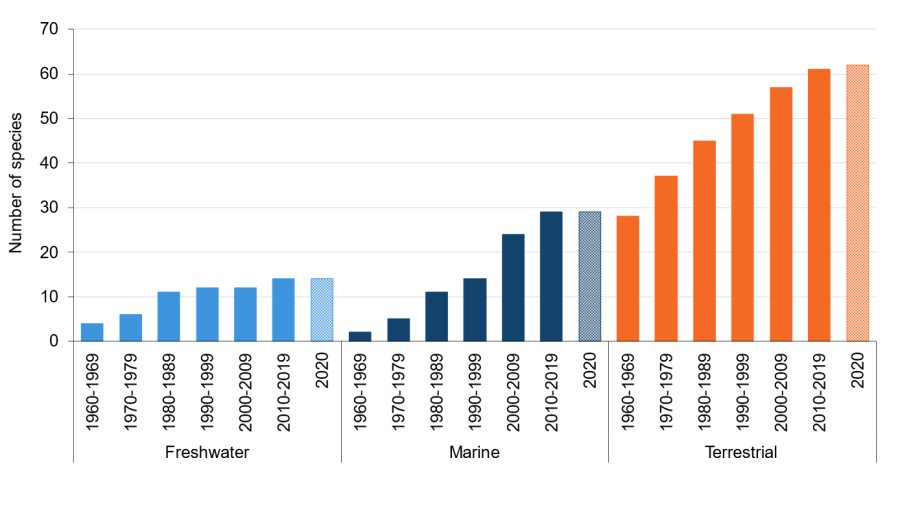
Figure 1 B6i: Number of invasive non-native species established in or along 10% or more of Great Britain’s land area or coastline, 1960 to 2020. Source: Botanical Society of Britain & Ireland; British Trust for Ornithology; UK Centre for Ecology & Hydrology; Marine Biological Association; National Biodiversity Network.
The Climate Change Committee (CCC)’s 2021 assessment of climate risks to the UK[10] highlighted INNS as a priority risk facing terrestrial, freshwater, and marine habitats and species, as well as agriculture and forestry. Climate change is expected to increase the risk from many NNS that are currently unable to establish. A combination of factors, such as frost-free winters and increased flooding events, will increase the range and abundance of many INNS. Stressed habitats may also be more vulnerable to invasion and disease, increasing the risk to biodiverse natural habitats. As a priority risk, with the highest urgency score, the CCC has recommended that further actions to address this should be put in place as soon as possible. The UK Government has committed to producing a more robust and ambitious 3rd National Adaptation Programme for 2023/28 in which actions to reduce this risk in England will be set out. The Welsh Government’s current 5-year National Adaptation Plan ‘A Climate Conscious Wales[11]’ includes a number of actions for addressing the risks from INNS in the context of climate change, and the next 5-year plan for Wales is due to be published in 2024. The Scottish Government’s current 5-year national adaptation programme ‘Climate Ready Scotland: Second Scottish Climate Change Adaptation Programme 2019/2024[12]’ likewise includes actions for managing increasing risks from INNS as the climate changes.
Today, about 10 to 15% of NNS established in GB cause significant adverse impacts. Aquatic species tend to be more invasive than terrestrial ones, and animals more invasive than plants. Impacts include:
- Environmental: disrupting habitats and ecosystems, preying on or out-competing native species, spreading disease, and interfering with the genetic integrity of native species. The ecological impact of some INNS, such as the American mink, signal crayfish and grey squirrel are well known, but many other impacts are less well documented
- Economic: the cost of INNS covered by the Strategy in GB is estimated to be £1.84 billion per year[13]. Much of this cost is borne by the agriculture and forestry sectors, but many other sectors, including transport, construction, aquaculture, recreation, and utilities, are also affected. Japanese knotweed alone is estimated to cost the British economy around £247 million per year[14]
- Social: some species cause problems to human health or are a nuisance. For example, giant hogweed sap can cause burns when in contact with human skin and combined with UV radiation. Invasive non-native plants, such as floating pennywort, clog water bodies preventing access for navigation and angling. Some significant threats to human health are posed by species that are not yet in GB but that could establish in the future, such as the Asian tiger mosquito that can act as a vector for serious diseases
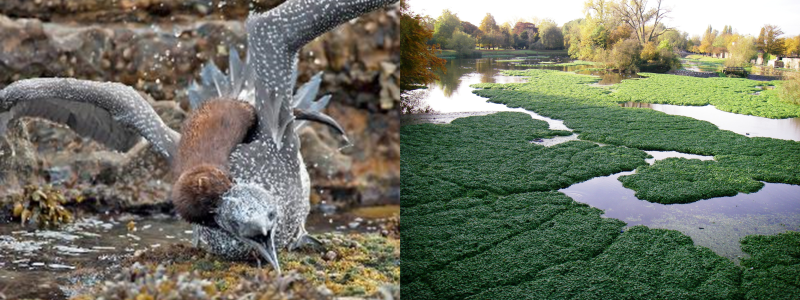
Figure 2 American mink attacking a gannet chick (left). Floating pennywort covering a waterbody (right). (Photos: John W Anderson, Environment Agency).
Acknowledging the growing threat from NNS, the CBD provides a major driver for international action. One of its guiding principles calls for national strategies on INNS. This Strategy provides the framework to support co-ordination of policy and action across GB, and aligns these efforts with national and international biosecurity and environmental strategies. While the 2015 Strategy covered a five-year period, this Strategy runs to 2030. bringing it in line with other environmental strategies and commitments. It takes account of the successes of the previous 2015 Strategy as well as the outcomes of the 2020/2021 review[15].
Successes of the 2015 strategy
A key objective of policy in GB has been to develop a strong partnership approach, with the 2015 Strategy providing a framework for supporting and co-ordinating action. The achievements since 2015 reflect this broad collaborative approach between governments, industry, NGOs, volunteers, and other stakeholders.
Since 2015, we have:
- eradicated American bullfrog from GB, have four more species in the process of being eradicated, and have continued work to eradicate ruddy duck,[16] which demonstrates GB’s commitment to safeguard biodiversity at an international level and is an international exemplar as the largest-scale bird eradication attempt in the world
- successfully implemented the joint Asian hornet contingency plan, together with Bee Health colleagues, annually since 2016
- analysed and prioritised pathways of introduction for prevention and developed three pathway action plans (PAPs) with stakeholders, with a fourth in development (read Chapter 3)
- developed and agreed generic contingency plans[17] outlining how government and operational partners will respond to an outbreak of an INNS
- continued to evolve our risk analysis mechanism, developing risk management to help prioritise species for eradication based on cost, risk posed and feasibility
- worked together with the Overseas Territories to enhance their biosecurity through various Foreign Commonwealth and Development Office and Defra-funded projects
- continued to support the non-native species information portal (NNSIP)[18], focussing on aspects such as its alert system and a second horizon scanning exercise
- developed an Evidence Strategic Plan[19] and funded strategic research, such as for biocontrol agents for a range of invasive non-native plants including Japanese knotweed, Himalayan balsam and floating pennywort
- continued to support the network of local action groups (LAGs) to facilitate strategic action at a local scale, making the most of the invaluable work that LAGs do
- expanded Invasive Species Week[20] and refreshed the 'Be Plant Wise' and 'Check, Clean, Dry' campaigns, that have been strengthened through new collaborative initiatives with stakeholders, such as with water companies on the Aquatic Biosecurity Partnership[21]
- implemented a new legal framework in each GB Administration that gives us important tools to tackle species of special concern[22] in GB, including improved enforcement measures at the UK border
- begun to establish a new NNS Inspectorate modelled on those in plant, animal, fish and bee health to bring our effort and level of success in managing NNS in line with other biosecurity regimes (read Chapter 9.2)
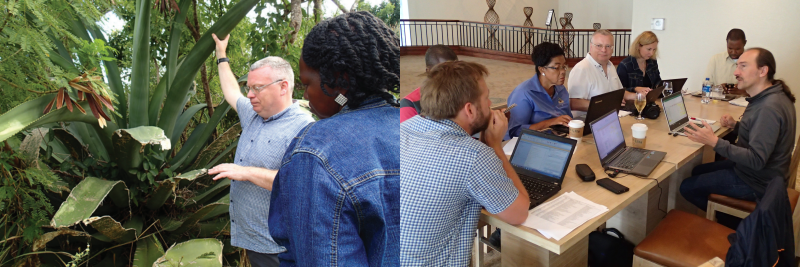
Figure 3 Checking native agave plants for pests in the British Virgin Islands (left). A horizon scanning workshop to identify non-native species which are a future threat to Overseas Territories in the Caribbean (right). (Photos: Jill Key).
Figure 4 A Non-Native Species Inspector working with Check Clean Dry partners to improve biosecurity at a paddling competition (photo: Non-Native Species Inspectorate).
Chapter 2: Aim and strategic outcomes
The overarching aim of the Strategy is to minimise the risk of introduction and establishment and reduce the negative impacts of INNS in GB through a strong partnership approach. This Strategy follows the CBD hierarchical approach, which emphasises prevention, followed by early detection and rapid response, and finally long-term management and control.
The key outcomes of the Strategy are that, by 2030 we will:
- Prevention: reduce establishments of INNS by at least 50% compared to 2000 levels
- Surveillance, early detection and monitoring: significantly improve our detection and monitoring capability, including increasing inspections and investigations
- Management: eradicate, control or contain INNS – prioritised by greatest impact and the likelihood of success
- Prioritisation and risk analysis: set out an agreed approach to the prioritisation of species based on risk and likelihood of success to ensure our efforts are focused to where they can achieve the greatest benefit
- Evidence: commission the research priorities outlined in the Evidence Strategic Plan, to ensure that the strategy is based on the best available evidence, and identify gaps and priority areas for further development
- Awareness raising: increase awareness of INNS issues and promote appropriate changes in behaviour or attitudes throughout all relevant sectors and among the general public
- Coordination: improve co-ordination of actions within governments, government associated bodies, and key actors outside government
Further detail on each strategic outcome is given in the subsequent chapters, where Objectives and Key Actions are provided. We will use metrics to help measure the implementation of the strategy and success in achieving the outcomes (as outlined in Chapter 11). Progress will be monitored and reported on annually (read Key Action 11.3).
Chapter 3: Prevention
The CBD Guiding Principles place a strong emphasis on prevention as the least environmentally damaging intervention, which maximises the reduction in adverse impacts and costs associated with tackling invasions. Prevention is important in all environments, particularly in aquatic environments where control and eradication are technically challenging. Acting on pathways of introduction, horizon-scanning and contingency planning are the key elements of prevention dealt with in this chapter. Other elements that contribute to prevention, including legislation, risk analysis, and public awareness are considered elsewhere in this Strategy.
Since 2015, there has been significant progress in promoting a greater emphasis on prevention. Six pathways have been identified as the highest priority based on risk of introduction of INNS: hull fouling, stowaways on fishing equipment, zoo or botanic garden escapes, contaminants of ornamental plants, horticulture escapes, and ballast water[23]. Pathway Action Plans have been developed for recreational boating, angling, zoos and horticulture to address these risks and will be finalised following consultation. Contingency plans[24] to respond to newly arrived INNS have been agreed for most taxa and environments across GB. In addition, the pilot for the new NNS Inspectorate has identified a need for increased capacity to inspect and investigate at both the border and post-border, in order to manage pathways of introduction and implement contingency plans more effectively (read Chapter 9.2).
With 10 to 12 new NNS becoming established each year, it is crucial that we are able to predict in advance which species are likely to be introduced, establish, spread and have an adverse impact. This is increasingly important as climate change may alter the risk of establishment of species and their potential impact[25]. Horizon scanning is thus a key element in prevention and is extremely important for guiding our efforts on risk analysis, pathway management and contingency planning, and in both 2013 and 2019 the NNSIP project carried out a horizon-scanning exercise. We will continue to foster this approach, being mindful of developments across Europe and of other approaches to biosecurity, particularly the Plant Health Risk Register. This will complement research to understand the changing risks under a future climate, as detailed in Chapter 7. We are also working to enhance risk management processes in forestry and woodland creation policies across GB in relation to INNS. Where new or novel tree species are proposed for woodland planting schemes in England and Wales forestry authorities will assess invasion risk from new or novel species proposed, including hybridisation, to help ensure risks are mitigated. In Scotland, an already established licensing system will continue to manage risks associated with planting non-native tree species.
Preventing the introduction and establishment of new INNS will continue to be a high priority in GB. We will seek to give priority to those pathways that pose the greatest risk and will complete the suite of PAPs for priority pathways, ensuring that they are effectively delivered and resourced. The new NNS Inspectorate will further strengthen existing work undertaken at borders and aim to integrate with the existing biosecurity regimes (such as Animal and Plant Health). We will continue to engage with BIC jurisdictions and with our neighbours through the Bern Convention to share intelligence on new species and pathway threats.
Case study: Asian hornet: the effectiveness of contingency planning
The Asian hornet (Vespa velutina) is an aggressive predator of honeybees and other insects. In 2004, this species was unintentionally introduced to France where it quickly became widespread, and it has also now become established in Spain, Belgium, Netherlands, Portugal, Italy, Switzerland and Germany. It reached the Channel Islands in 2016.
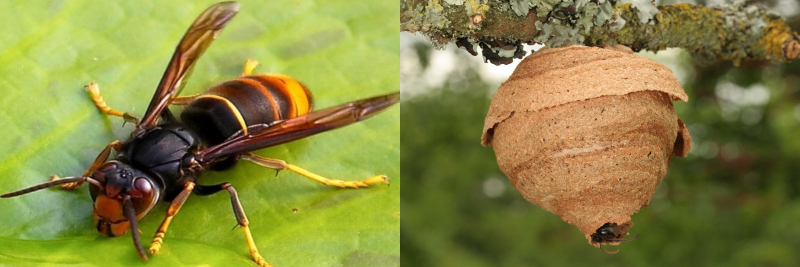
Figure 5 Asian hornet and a nest
To address the concern that Asian hornet would reach GB a risk assessment was commissioned in 2011, followed by an assessment of the management options and a contingency plan (for England and Wales), which was developed with the aim of rapidly intercepting and preventing its establishment in GB. This was then used to develop a Pest Specific Contingency Plan for Asian hornet describing the action that government will take if Asian hornet is discovered in GB. An alert system was established (including the Asian Hornet Watch App) which allows the public to quickly and easily report sightings.
Asian hornet was first detected in GB in 2016 and the contingency plan was rapidly deployed. Animal and Plant Health Agency staff detected and destroyed the nest in under a week. As of the end of 2021, 12 nests have been detected and destroyed (read Figure 7). The maximum number of nests found in any year was 3 in 2018. Even accepting the pathway of introduction is more straightforward given Belgium’s land border with countries where Asian hornet is well established, there is a clear contrast in the development. In Belgium, Asian hornets were also first found in 2016 and the number of nests detected and destroyed in 2021 was 346, compared with 2 in GB (read Figure 6).
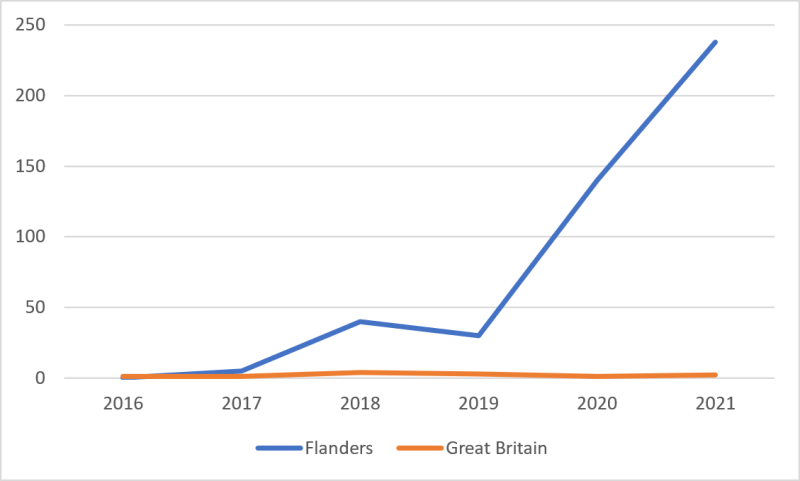
Figure 6 Detected Asian hornet nests in Flanders, Belgium and Great Britain (2016 to 2021)
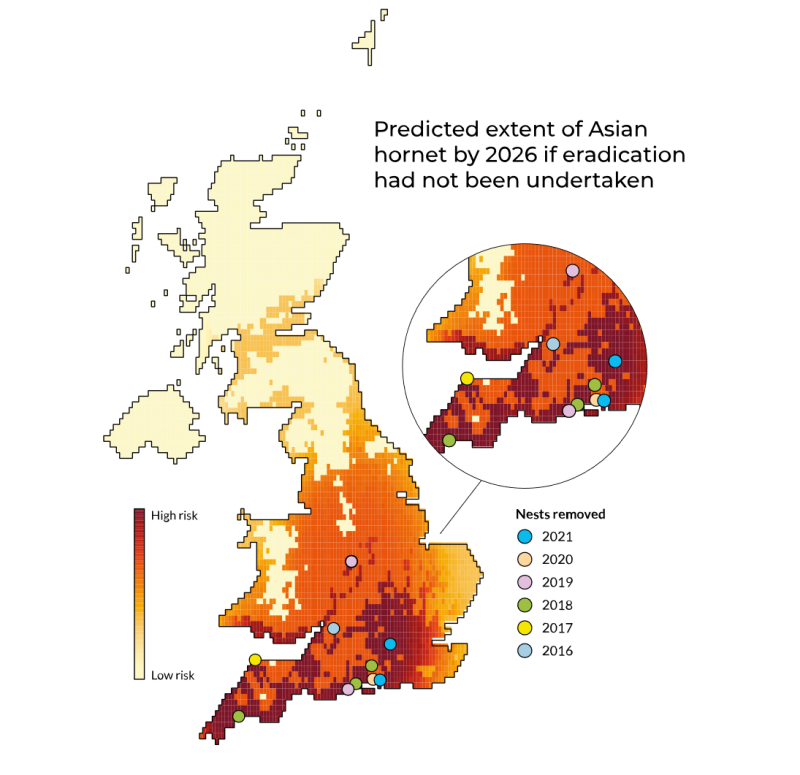
Figure 7 Map of the UK showing the predicted extent of Asian hornet spread by 2026 if eradications had not been undertaken and the locations of Asian hornet nests that have been identified and removed between 2016 and 2021. Source: UK Centre for Ecology and Hydrology.
Objective
To reduce the number of establishments of INNS each year by comprehensive pathway action and contingency responses resulting in at least a 50% reduction in establishments in 2030 compared with 2000 levels.
Key actions:
We will:
Key Action 3.1
Complete the development of Pathway Action Plans (PAPs) for the six priority pathways and develop future PAPs in partnership with relevant stakeholders;
Key Action 3.2
Support and encourage the effective implementation and delivery of Pathway Action Plans (as detailed in each plan);
Key Action 3.3
Seek greater engagement with other countries to improve pre-border prevention;
Key Action 3.4
Implement border and post-border inspections and investigations for priority species (read Chapter 6), ensuring appropriate integration with existing biosecurity regimes and other agencies;
Key Action 3.5
Continue to undertake horizon scanning of emerging threats, including carrying out a horizon scanning exercise involving a broad range of stakeholders every 5 years;
Key Action 3.6
Finalise, test and implement contingency plans, ensuring they are kept up to date with changes in evidence, governance and legislation, and track decisions made in response to new incursions;
Key Action 3.7
Foster and develop expertise and capacity for delivering contingency responses across government and relevant stakeholders, for example by sharing capacity with the animal and plant health regimes.
Key Action 3.8
Establish a task and finish group to review the coordination of prevention work and make recommendations to tackle marine INNS.
Chapter 4: Surveillance, early detection, monitoring and rapid response
4.1 Surveillance, early detection, monitoring
Accurate, up-to-date information on NNS distributions is fundamental to making effective decisions that minimise their threat, and to assess whether preventative measures and other objectives have been successful. Since 2008, the GB Non-Native Species Information Portal (NNSIP) and the National Biodiversity Network (NBN) Atlas[26] have provided a central hub for NNS records in GB (read Figure 8).
Since 2015, the alert mechanism has been refined and updated to make the best use of new technologies and there has been progress in improving the quantity of NNS records, demonstrated through an escalating number of reports on the alert system. Citizen science initiatives and online systems, such as the ‘Plant Alert[27]’ and ‘Asian Hornet Watch[28]’ apps, have further increased the efficiency of NNSIP and the alert system. Going forward, there are still opportunities for improvements, such as ensuring that the process of triaging and responding to alerts is as rapid as possible and that the efficacy of information flow and updates to the species register are improved. Additional surveillance requirements are imposed on GB by the UK Marine Strategy Regulation[29] and also for INNS that are listed as being of special concern (read Chapter 9.2). To make the best use of the NNSIP and wider surveillance mechanisms, we need to continue expanding our engagement with the public, LAGs, and organisations that can help to increase data flow, as well as improving the number of records that are made.
Defra, Scottish Government and Welsh Government will continue to support the development and promotion of the NNSIP and improvement of the alert system. All three governments are committed to improving triaging processes and responses to alerts such that both are as rapid as possible, as well as continuing to build the quality, quantity and rate of flow of NNS records in GB.
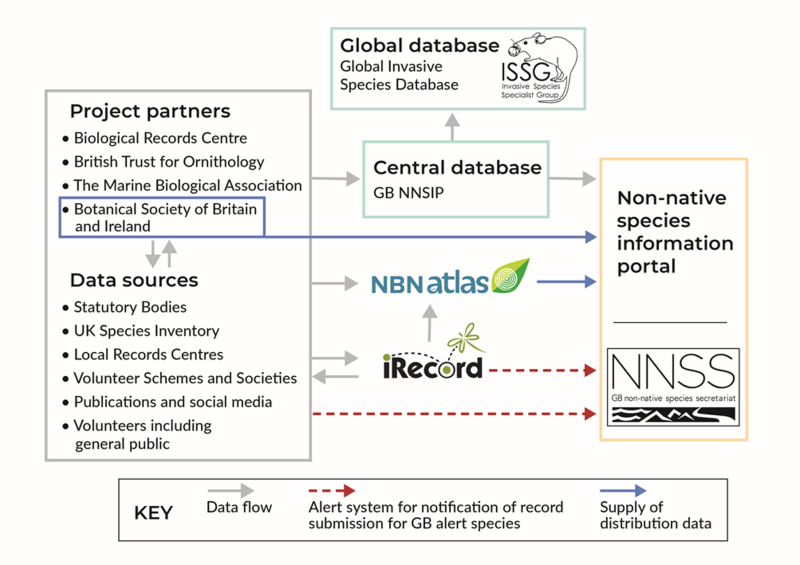
Figure 8 Diagram to show the structure and data flow of the NNSIP, and how it interacts with the wider community engaged in monitoring and surveillance of NNS. Source: UK Centre for Ecology and Hydrology.
Objective
To develop and maintain a surveillance, early detection and monitoring mechanism that facilitates management responses, including rapid response, and fulfils the requirements relating to species of special concern.
Key actions:
We will:
Key Action 4.1
Continue to maintain and develop the NNSIP;
Key Action 4.2
Work with the NNSIP and other data collectors and organisations to increase the speed of data flow between organisations and data organisations/systems;
Key Action 4.3
Improve surveillance and recording of NNS by continuing to work with and support recording schemes, networks, LAGs and citizen science initiatives, and seek new opportunities to work with professional organisations that regularly conduct ecological surveys;
Key Action 4.4
Continue to improve the alert system in GB so that it is robust, with clear protocols, resources for verification and prompt reporting;
Key Action 4.5
Develop dedicated surveillance for priority species and pathways;
Key Action 4.6
Support an alert system for the eight jurisdictions of the British-Irish Council.
4.2 Rapid response
Measures to prevent the introduction of INNS into GB will not always be successful. Therefore, the sooner action is taken to address any threat, the greater the chance of success and the less costly it will be. The precautionary approach in the CBD suggests that action should be taken to eradicate a NNS or prevent its spread where it represents, or is likely to represent, a threat. This requires sufficient operational capacity and resources.
The rapid response working group was re-established in 2015. It carried out lessons learned on past responses, prioritised species for eradication using risk management methods (that were developed by the GB NNS Secretariat) and assessed the resourcing and specialist capacity needs to carry out these eradications. The outputs of the working group fed into the 2018 resourcing needs assessment and subsequent funding bids. Despite this progress, however, only four species have been eradicated from GB since 2008 (the African clawed toad, fathead minnow, American bullfrog and black bullhead) with only one of these since 2015. Eradications are still ongoing for water primrose, variable-leaved water milfoil, topmouth gudgeon and monk parakeet. In addition, the generic contingency plans have been initiated at least ten times for six different species, including raccoon and raccoon dog. This low number of complete eradications is mainly due to the need for significantly greater resources for prevention, as a contingency for rapid responses, compared with that for long-term control and a lack of capacity, expertise and effective methods of control.
We will aim to step up action including by delivering rapid responses to all key species listed in the annexes of contingency plans[30], as well as to other new arrivals where they are considered a threat and where eradication is feasible and cost-effective. We will seek to ensure sufficient funding and operational capacity are in place and to continue to coordinate GB-level responses, including by establishing the role of the NNS Inspectorate in rapid responses (read Chapter 9.2).
Case study: Invasive fish eradications
Since 2005, the Environment Agency have been using the piscicide Rotenone to manage non-native fish populations in GB. To date, two invasive fish species — the fathead minnow (Pimephales promelas) and black bullhead (Ameiurus melas) — have been eradicated from GB, with an on-going eradication programme for topmouth gudgeon (Pseudorasbora parva).
Topmouth gudgeon is a highly invasive cyprinid fish species, originating from Asia, but has achieved a pan-continental distribution in Europe since its introduction to Romania in 1960. They are capable of establishing populations rapidly, in part due to their high fecundity and rapid sexual maturation. Topmouth gudgeon have been shown to directly compete with native fish species for food and other resources, but also predate upon fish eggs and can host novel non-native diseases and parasites.
Since their introduction to the UK in 1984, topmouth gudgeon have been found in 42 waters across England and Wales. In 2008 the Non-native Species Programme Board decided that this was one of the priority species for GB-level rapid response and, by 2022, they have been eradicated from nearly 70% of the known locations (nearly all by the Environment Agency). The aim is the complete removal of this high priority species from GB. The eradication programme has led to the development of the tools, expertise and capacity to better manage current and future invasions from aquatic species. An active surveillance programme for topmouth gudgeon is also underway, utilising traditional trapping methods and the latest developments in environmental DNA analysis to detect new populations of topmouth gudgeon in order to inform the eradication programme.
Using the results of an extensive monitoring programme in south Wales, Natural Resources Wales has undertaken a feasibility study for eradication of topmouth gudgeon at these sites alongside the introduction of biosecurity measures, including signage and awareness raising. Initial eradication work at two sites is planned for winter 2022/23.
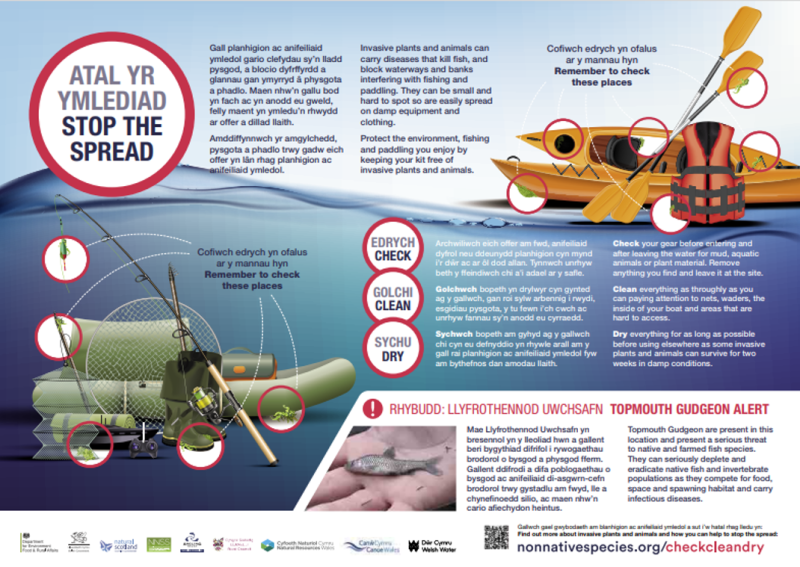
Figure 9 Adapted Check Clean Dry posters with topmouth gudgeon alert information have been displayed at sites in Wales.
Objective
To further prioritise rapid responses and maintain and develop capacity to carry them out.
Key actions:
We will:
Key Action 4.7
Use risk management methods to help identify and prioritise further species for eradication through rapid response in GB;
Key Action 4.8
Make rapid response to eradicate INNS a clear priority for the Programme Board. In doing so, the Programme Board will seek regular updates on progress;
Key Action 4.9
Re-convene the Rapid Response Working Group to:
- review progress to date and make recommendations for stepping up delivery of rapid responses
- engage with industry and NGOs to define their roles in supporting rapid eradication initiatives
- review media and communications lessons learnt about sensitive eradication attempts and provide guidance to the operating bodies for improvement
- review technical aspects of rapid responses, making recommendations for improving exchange of technical information
Key Action 4.10
Identify and foster capacity and expertise in carrying out rapid responses, including through sharing good practice within GB, as well as with Northern Ireland, the British-Irish Council jurisdictions and internationally.
Key Action 4.11
Coordinate work to secure sufficient funding and operational capacity for rapid responses, including establishing the role of the NNS Inspectorate
Key Action 4.12
Instigate and carry out rapid response eradications for GB priority species.
Chapter 5: Long term management and control
Some INNS that are established in GB, such as floating pennywort, grey squirrel, and Japanese knotweed, require long-term management. This could be large-scale eradication, containment, or control, all of which often require significant resource and expertise. In practice, we prioritise the long-term management of around 20 of the most impactful species. For some widely-spread species, biocontrol is a key tool to help reduce their impact.
Since April 2011, Defra, in partnership with the Welsh Government and Natural England has been funding research into biocontrol of aquatic and riparian INNS[31]. Most recently, after a decade of research, approval has been given to release a non-native weevil in England to complement existing control methods for floating pennywort[32]. We are committed to continuing to support the development of such approaches in order to improve long-term management of widespread, priority INNS. We are also investing in novel methods of grey squirrel management (read Chapter 7). By 2030, we hope these novel methods will offer more effective, less labour intensive, and more widely acceptable approaches to managing the impacts of these species, complementing the management actions set out at the level of individual governments.
We have supported Local Action Groups (LAGs) to carry out control on a wide range of INNS, including through running national scale coordination projects such as the Wales Resilient Ecological Network (WaREN) project[33], the Scottish Invasive Species Initiative (SISI)[34] and RAPID LIFE[35] in England. We will continue to support LAGs through providing improved coordination, resources and funding. Defra will fund a full-time LAG coordinator, hosted by the Animal and Plant Health Agency for the strategy period, and explore opportunities to provide additional support as this key role develops.
Implementing biosecurity measures is our first line of defence to help prevent accidental introduction of INNS, or to contain the spread of INNS that are already present. This is particularly important where eradication may not be possible, such as in the marine environment (read the Marine Management case study). We have helped to implement biosecurity measures and started to increase awareness, working with groups, such as the BIC Biosecurity in Aquaculture Working Group and the Aquatic Biosecurity Partnership. We will continue to improve awareness of, and compliance with, good biosecurity practice, as outlined in Chapter 8.
Case study: Tackling established INNS through local action
There are over 50 Local Action Groups (LAGs) in GB working with volunteers to reduce the risks and impacts associated with INNS in their local area.
LAGs are invaluable in delivering sustainable, long-term management of a number of invasive non-native species at a local and regional level. Not only do they control species that are widespread across GB, LAGs also tackle species which are a local issue, helping to prevent them from establishing more widely. They also play a vital role in monitoring and early detection, and have even carried out national eradications.
A huge amount of work is carried out by LAGs to raise awareness amongst their local communities of the risks and impacts associated with INNS. They play a key part in delivering the ‘Check Clean Dry’ and ‘Be Plant Wise’ campaigns, provide training and advice to local stakeholders, and have developed fantastic resources including education packs, biosecurity protocols, and identification materials. LAG support has been instrumental in building ‘Invasive Species Week’.
The work of volunteers has been extremely important in the success of LAGs.
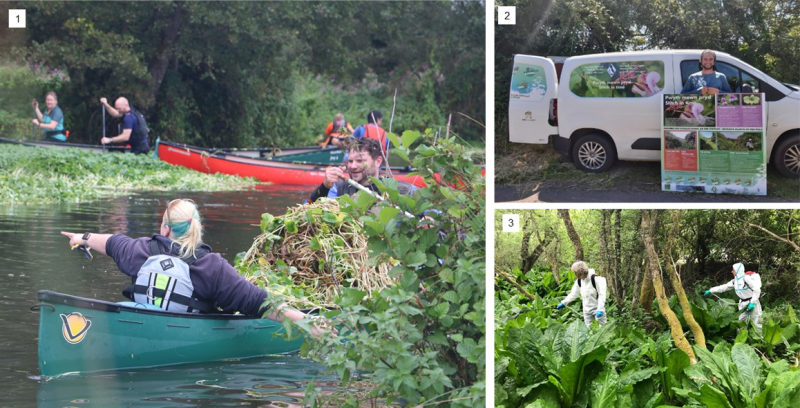
Figure 10 (left) Volunteer anglers and paddlers are working together to help tackle floating pennywort under the GB Floating Pennywort Strategy (Photo: The Angling Trust) (top right) LAGs raise awareness of INNS to local stakeholders (Photo: Stitch in time project) (bottom right) LAGs control a range of INNS, from widespread species to local issues, such as American skunk cabbage (Photo: SISI).
Objective
To minimise and manage the impact of established INNS in a cost-effective and strategic manner.
Key actions:
We will:
Key Action 5.1
Continue to support national and regional scale co-ordination projects for managing INNS, that bring together LAGs, industry and government bodies.
Key Action 5.2
Improve ways of supporting strategic local action including:
- seeking ways to assist LAGs, for example by providing funding for co-ordinators
- seeking relevant, long-term and timely funding mechanisms for LAGs
- developing greater co-ordination between INNS experts and LAGs
- continuing to support the development of recording tools and mechanisms
Key Action 5.3
Seek ways to ensure that INNS management is included in relevant new initiatives where possible, including new agricultural and land management schemes.
Key Action 5.4
Encourage habitat restoration after INNS control where appropriate and integrate INNS control into landscape scale nature restoration projects.
Case study: Marine management
Marine INNS negatively impact both biodiversity and the economy, threatening native species resilience, aquaculture stock health and vessel and equipment integrity and function. They may be spread through a range of pathways, including unintentional transportation (for example, via shipping), intentional releases or escape from confinement. In response to the challenges posed by marine INNS eradication, a number of measures are being implemented to minimise their introduction and spread.
In 2020, the BIC Environment sub-group produced an INNS Action Plan for Didemnum vexillum (carpet sea squirt). In collaboration with the aquaculture industry, the Action Plan aims to reduce negative impacts of D. vexillum by improving capacity to detect, report and prevent the spread of D. vexillum and other INNS. The Biosecurity in Shellfish and Integrated Aquaculture Working Group addresses one of the Objectives under the Action Plan and is currently drafting a voluntary biosecurity protocol to support shellfish and integrated aquaculture operations. The Protocol aims to build upon existing biosecurity practices already in place for fish health and disease and to enable better monitoring and reporting of marine INNS from the shellfish sector.
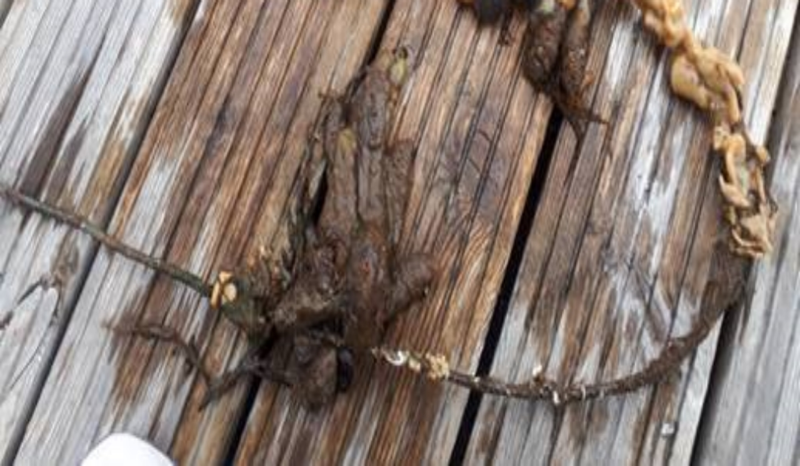
Figure 11 Didemnum vexillum on an artificial marina structure (Photo: Marine Scotland).
As part of addressing the transportation pathways, operators are encouraged to follow the International Maritime Organisation’s (IMO) voluntary guidelines for the control and management of ships’ biofouling. Additionally, marine licensing in England makes links to best practice guidance on how to avoid and minimise biofouling, such as through hull cleaning. In Wales, the Welsh National Marine Plan requires that proposals demonstrate how they will avoid or minimise the risk of introducing and spreading INNS and, where appropriate, include biosecurity measures to reduce this risk. In Scotland, the Scottish National Marine Plan aims to identify opportunities to reduce the introduction of INNS to a minimum and to proactively improve existing practices through the highest standards of biosecurity.
Further to this, the UK acceded to the Ballast Water Management Convention (BWMC) on the 26 May 2022. The UK domestic legislation entered into force on 29 July 2022. The BWMC aims to regulate discharges of ballast water and reduce the risk of INNS introduction.
Chapter 6: Prioritisation and risk analysis
There are approximately 2,000 NNS established in GB[36], 10 to15% of which have become invasive and cause adverse impacts. More NNS will also arrive and have an impact in future. With finite resources, it is essential to prioritise species for action.
The GB risk analysis mechanism was developed to help prioritise species. Starting in 2007 it has long supported decision making for the NNS Programme Board.
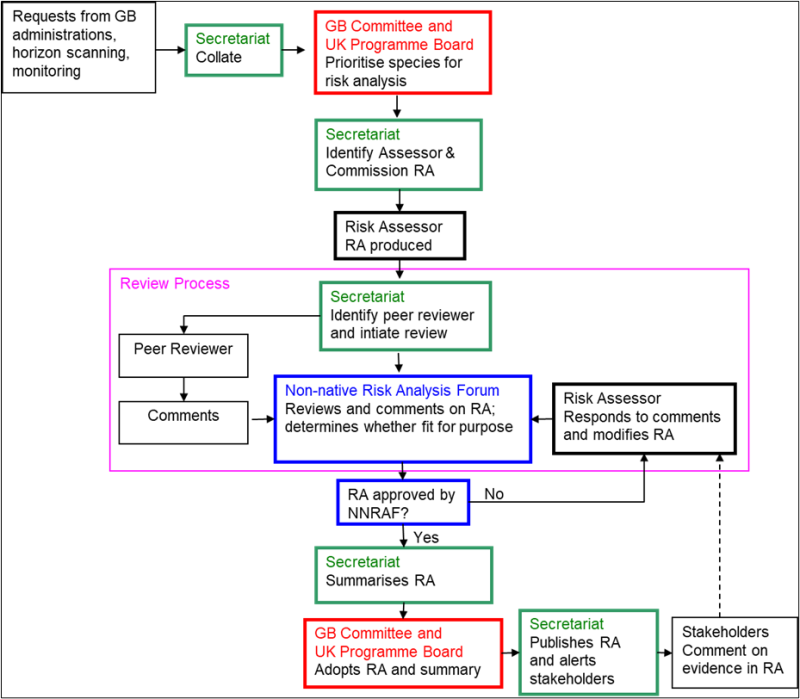
Figure 12 The GB Non-native Risk Assessment (RA) process
In total 120 risk assessments have been published by the mechanism, compared to 60 at the time the 2015 Strategy was published. There are also 44 risk assessments in progress. The taxa covered by the assessments include a wide range of marine, freshwater, and terrestrial plants and animals (Table 1). As a proportion of all known established non-native species in GB, approximately 3% of the risk assessed species have been terrestrial, 24% marine and 58% freshwater.
|
Taxa |
Terrestrial |
Marine |
Freshwater |
|
Plant |
17 |
3 |
20 |
|
Invertebrate |
8 |
15 |
16 |
|
Vertebrate |
28 |
0 |
13 |
Table 1 Number of species that have been risk assessed within each taxonomic group and environment within GB.
There have been major developments relevant to risk analysis since the 2015 Strategy. Our risk analysis mechanism was used as a model for IAS risk analysis in the EU, with an adapted version of our risk assessment template providing the basis for most IAS risk assessments at an EU level. This mechanism now fulfils a statutory role supporting the GB Committee, which advises Ministers on listing and de-listing of species of special concern, and is overseen by the Non-Native Species Risk Analysis Forum (NNRAF). In addition, we have developed the risk analysis templates to ensure that they follow international good practice, developed and implemented risk management assessments, produced risk assessment summary sheets to effectively communicate results, and assisted the application of GB risk analysis tools in the UK Overseas Territories and elsewhere.
It is important to continue to ensure that risk analysis in GB is carried out to a high standard, develops in line with international good practice, and that risk assessments are updated as new information becomes available. The review of the 2015 Strategy identified the need for more risk management information to be gathered, ideally in parallel to risk assessments.
We will continue to run the GB risk analysis mechanism, with an emphasis on maintaining high standards and gathering more risk management information, and continue to use it to support decisions on the listing of species. We will also continue to develop the tools available for risk analysis, learning from international good practice, and endeavor to communicate the results effectively.
Objective
To maintain and further develop a risk analysis framework to support legislation, decision-making and prioritisation.
Key actions:
We will:
Key Action 6.1
Continue to run the GB risk analysis mechanism to support the listing of species of special concern and other decision making on behalf of the GB Committee and UK NNS Programme Board;
Key Action 6.2
Further develop the risk analysis mechanism to support strategic prioritisation of resources and action, including gathering risk management information in parallel with risk assessments;
Key Action 6.3
Clearly demonstrate the links between risk assessments, risk management and policy decisions so as to facilitate transparency, clarity and communication;
Key Action 6.4
Continue to review and revise the risk analysis mechanism in the light of national and international developments.
Chapter 7: Evidence
Evidence is key to informing action on NNS. It is vital that policy is underpinned by a strong evidence base, and research outcomes will often be a key component in informing risk assessment, surveillance, detection, monitoring, control, and eradication strategies, as well as public awareness activities.
Considerable progress has been made on some elements of strategic research, notably work on biocontrol, economic impacts and public attitudes as well as horizon scanning, aspects of risk analysis and on pathways. An update to the economic costs of INNS was commissioned in 2022[37]. A review of the direct costs has been completed, focussing on financial control costs and market impacts of INNS as an update to the previous 2010 figure[38]. A second update is also planned to investigate wider and non-direct impacts under a natural capital approach.
A key action under the 2015 Strategy was to establish a Research Working Group to help improve co-ordination of evidence, including the development of a strategic plan. Consequently, the working group was established in 2018 with the aim of agreeing a strategic plan to include identification of key evidence needs, agreeing mechanisms for reviewing these and for promoting optimal interaction with research funders and researchers. The draft GB INNS Evidence Strategic Plan was signed off by the Programme Board in March 2022. The GB INNS Evidence Strategic Plan[39] includes six key priority areas of future evidence needs:
- impacts of INNS
- economic and wider social science evidence
- pathways
- surveillance and early detection
- rapid responses and longer-term control/eradication
- species prioritisation
We are committed to ensure the delivery of the evidence strategic plan in order to maintain a robust evidence base and to continue to support innovative research, such as biocontrol and grey squirrel fertility control.
Objective
To promote robust, strategic and coherent research activities and partnerships to inform evidenced-based NNS policy making and action.
Key actions:
We will:
Key Action 7.1
Convene the research working group biannually to oversee the delivery of the INNS evidence strategic plan;
Key Action 7.2
Deliver the priorities and recommendations set out in the INNS evidence strategic plan, in collaboration with the research community;
Key Action 7.3
Seek funding opportunities and partnerships for our strategic research priorities;
Key Action 7.4
Seek opportunities to collaborate with international partners for example, through the British-Irish Council, Bern Convention expert group on invasive alien species and OSPAR in order to maximise benefits and reduce duplication of effort;
Key Action 7.5
Promote the sharing of research and encourage practitioners to record, report and share good practice and lessons learnt in an accessible way, including scoping the potential for an annual conference between the Research Working Group and the wider research community;
Key Action 7.6
Continue to support the development and roll-out of biocontrol and other novel control methods to improve the long-term management of widespread INNS.
Case study: Fertility control for grey squirrel
In GB there are an estimated 2.7 million grey squirrels[40] that are threatening our native wildlife and ability to achieve our environmental targets. The range of red squirrels has contracted considerably and their populations in England have reduced to an estimated 38,900[41] (from an estimated historic population high of 3.5 million) due to the fatal transmission of squirrel pox virus and competition from grey squirrels. Grey squirrels are perceived to be one of the greatest threats to the health of broadleaved trees[42]. It is estimated they cause at least £37m a year worth of damage to trees in England and Wales[43].
Trapping and shooting can be effective in managing grey squirrels but can also be labour intensive, expensive and the work must be repeated each year to maintain the effect. They are also publicly unacceptable methods in some contexts. Innovative methods of fertility control are being explored as a potential solution to manage grey squirrel impacts.
Since 2016, Defra has been contributing funding to fertility control research led by APHA and the UK Squirrel Accord (UKSA). An oral, bait-delivered contraceptive vaccine has been identified and is being tested in captivity trials. A feeder has also been designed that can distribute such a vaccine to free-living grey squirrels while excluding non-target species. Initial results suggest fertility control, when applied following short-term culling, could achieve local eradication within the same timescales as continuous culling alone but with substantially lower costs[44].
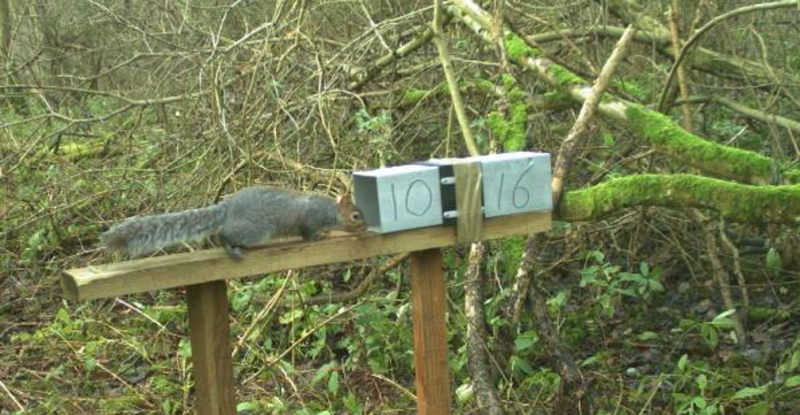
Figure 13 A grey squirrel visiting a bespoke feeder designed to distribute a fertility vaccine to this species only (Photo: Animal and Plant Health Agency).
Each of the GB administrations are signatories to the UKSA. We will continue to work in partnership with UKSA partners to help reduce the impacts of grey squirrels in our woodlands. This includes continuing support from UK Government for innovative grey squirrel work such as fertility control.
Chapter 8: Building awareness and understanding
Improved awareness and understanding of the impacts of INNS are important in gaining support for relevant policies and programmes, and for engaging the public. It is also vital to encourage behaviour change where activities carry the risk of introduction or spread of INNS.
Significant progress has been made in this area since 2015. An updated Media and Communications Plan[45] was published in 2017 and all actions in it have since been completed or are in progress. Follow-up research on public and stakeholder attitudes in England[46] was commissioned in 2018. The findings have been used to underpin communications work, including redevelopment of our awareness raising campaigns: ‘Check Clean Dry’[47] (relaunched in 2018) and ‘Be Plant Wise’[48] (relaunched in 2020). ‘Check Clean Dry’ has also expanded into a biosecurity campaign at the border targeting water users travelling abroad. These and other activities have been funded by water companies through the Aquatic Biosecurity Partnership. In addition, we have continued to grow our annual Invasive Species Week involving over 265 organisations in 2022, the Wales Resilient Ecological Network (WaREN) project have launched the ‘Ecosystem Invaders’ campaign in Wales, and the Scottish Invasive Species Initiative (SISI) run education programmes for schools and community groups in Scotland; all to raise awareness about the impacts of INNS. The GB NNSS website has been redeveloped based on feedback from stakeholders and further online training materials in biosecurity have been developed.
We work closely with colleagues from other biosecurity regimes, including on initiatives such as Plant Health Week and Asian Hornet Week[49] and have supported individual projects focusing on biosecurity and awareness raising such as Biosecurity for LIFE[50], RAPID LIFE[51], SISI[52], and development of a biosecurity plan for the Pen Llŷn a’r Sarnau Special Area of Conservation[53]. We are also expanding the reach of our awareness work in collaboration with the British-Irish Council (BIC), which has led to the adoption of ‘Check Clean Dry’ and ‘Be Plant Wise’ across all eight BIC jurisdictions, as well as a joint Invasive Species Week. The NNS Inspectorate is likely to have an important role in raising awareness of biosecurity amongst key sectors (read Chapter 9.2).
Uptake of good biosecurity practice amongst recreational water users has increased significantly[54] helping to tackle priority pathways, but there is still progress to be made here, as well as with gardeners and the general public. We will continue to expand our use of traditional and novel media channels to reach these key audiences and work towards integrating INNS issues into multiple tiers of education, and professional sector training.
Case study: The Aquatic Biosecurity Partnership: working with water companies to protect against invasive aquatic species
Invasive aquatic species are a serious concern for the water industry and already cost water companies at least £7.5 million a year[55], a figure expected to rise with increasing numbers of new introductions.
In order to limit future costs, maintain services, and help protect the environment, over £1 million has been invested by a group of water companies from 2017 to 2025 in a project to improve aquatic biosecurity. Delivery of the work programme is led by the GBNNSS and supported by a steering group consisting of water companies, Defra and its agencies, and Check Clean Dry partners.
Highlights of the project to date include:
- six annual Check Clean Dry border biosecurity campaigns held to remind recreational water users to clean their kit after travelling abroad, including 75 posters at ports and 57 adverts in magazines
- redevelopment of the Check Clean Dry and Be Plant Wise campaigns, with the launch of over 50 new materials to help raise awareness
- dissemination of over 1000 Check Clean Dry signs to angling, boating and paddling clubs across the country
- publication of a large survey of key stakeholder awareness and behaviour showing increased uptake of good biosecurity behaviour amongst recreational water users since Check Clean Dry was launched
- development of an online biosecurity training module for water company staff
- increased biosecurity at events through funding of biosecurity stations, development of biosecurity guides for angling and paddling event organisers, and the purchase of high-performance pressure washers
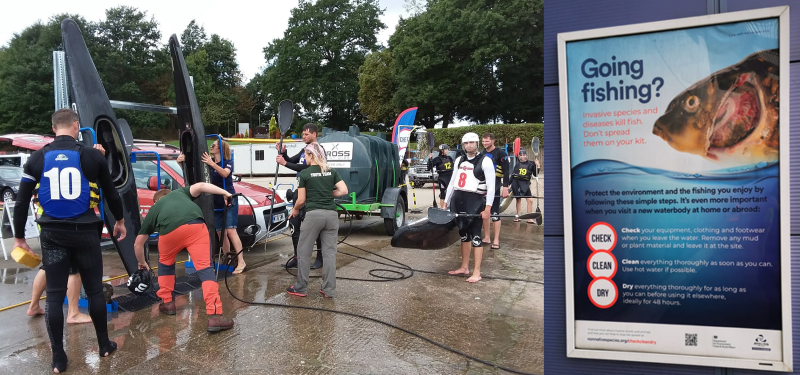
Figure 14 A biosecurity station at a paddling competition and Check Clean Dry poster displayed at key ports, both funded by the Aquatic Biosecurity Partnership (Photos: North Wales Wildlife Trust, GB NNSS).
The project entered its second phase in 2020 and currently involves the following nine water companies: Affinity Water, Anglian Water, Northumbrian Water, Severn Trent Water, South East Water, South West Water, Southern Water, Wessex Water, Yorkshire Water. Find out more about the Aquatic Biosecurity Partnership.
Objective
To raise awareness of INNS issues among key target audiences and, where appropriate, the general public in order to bring about behaviour change.
Key actions:
We will:
Key Action 8.1
Continue to build on the successes of existing campaigns, working with stakeholders in GB and neighbouring countries to make better use of mechanisms to disseminate consistent messaging, including recommended reporting routes and evaluating and revising the campaigns where necessary;
Key Action 8.2
Charge the Media and Communications Working Group with:
- reviewing its existing plan and obtaining input from stakeholders and specialists in further communications support
- increasing coverage of INNS issues in traditional and novel media to improve understanding amongst key stakeholders and the general public
- supporting the communications actions identified in the Pathway Action Plans
- supporting the communications work of the NNS Inspectorate, for example to inform stakeholder groups and the general public of their responsibilities and relevant legislation
Key Action 8.3
Work with stakeholders to integrate INNS into educational outreach programmes, professional sector training, and resources for educational institutions of multiple levels, developing further resources where necessary;
Key Action 8.4
Continue to assess public attitudes and evaluate the effectiveness of communication campaigns to inform the communications strategy;
Key Action 8.5
Work with stakeholders from across the biosecurity spectrum in GB and neighbouring countries to develop consistent messaging around biosecurity and maximise opportunities for collaboration;
Key Action 8.6
Maintain, update and develop the NNSS website, building on the relaunch in April 2022, to ensure that it is accessible and up-to-date.
Case study: American lobster awareness campaign
American lobsters (Homarus americanus) threaten the native European lobster (Homarus gammarus) by introducing disease, competing for food and shelter, and by interbreeding. Every year a small number of reports are received of American lobsters being caught in GB waters. These animals cannot cross the Atlantic naturally and therefore have appeared in GB waters because people have either deliberately or accidentally put them there.
American lobsters have been imported live for consumption from Canada and the US since the late 1950s with the first records of them in GB waters occurring in 1988, and a further 25 by 2011. In 2015 two individuals were fined almost £30,000[56] for releasing non-native species, including American lobsters, off the Sussex coast.
As a result of this incident and continued sightings, campaigns such as the ‘Retain and Report’ campaign[57] by Centre for Environment, Fisheries and Aquaculture Science, were launched across the UK administrations. The aim of these campaigns is to inform fishers that catching and landing the animals is not illegal, would not result in the closure of the waters and would provide data that could help to protect native stocks. The ‘Retain and Report’ campaign provides an identification guide through a leaflet, a poster and a webpage which was launched and shared widely on social media. The campaign also explain who should be contacted in the event that an American lobster is caught. It is hoped that the campaigns will provide confidence in the occurrence levels being reported by fishers.
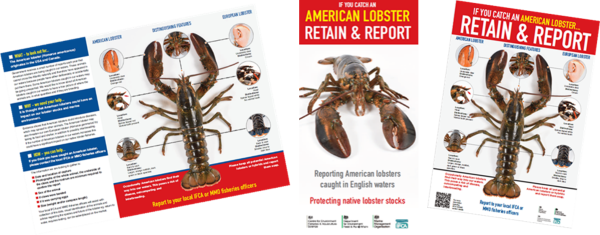
Figure 15 'Retain and report' campaign materials.
Chapter 9: Cross-cutting provisions
9.1 Governance and co-ordination
The delivery of this Strategy is overseen by the UK Non-Native Species Programme Board (UKNNSPB or ‘the Programme Board’) and its Secretariat (GBNNSS - the GB Non-native Species Secretariat), which acts on its behalf. The GBNNSS also serves the Non-Native Risk Analysis Forum (NNRAF) and various working groups that report to the Board. In addition, a Stakeholder Forum, which brings together representatives from a range of sectors to discuss strategic issues, has been running since 2004 alongside other working groups set up by the Programme Board as necessary. Country-level working groups in Scotland, Wales and England bring together key stakeholders from the public, private and voluntary sectors to help identify local INNS priorities and resolve country-specific issues. Although closely tied to the GB work, the country-level working groups are not governed by the Programme Board. More information on the governance supporting the GB Strategy is set out at Annex 1.
The 2015 Strategy set out to address concerns raised during the review of the 2008 Strategy regarding the strategic nature of the Programme Board, a need for greater transparency, and more stakeholder involvement in decision-making. Since then, the England Working Group has been re-convened to complement those in Scotland and Wales, and the GBNNSS has assisted in making the Programme Board more strategically focused, notably by carrying out a comprehensive review of resource needs in 2018[58].
To facilitate implementation of the retained IAS Regulation[59], it was necessary to make changes to existing governance structures. The following arrangements were put in place in 2021:
- membership of the GB NNS Programme Board was expanded to include Northern Ireland and it became the UK NNSPB
- the GB Non-Native Species Committee (GBNNSC) was established to advise Ministers of England, Wales and Scotland on the listing and de-listing of species of special concern and other matters relating to species of special concern (read Chapter 9.2)
- the NNRAF provides scientific advice to the GBNNSC and UKNNSPB in relation to risk analysis
Further details about the GBNNSC and other related groups can also be found in Annex 1.
The review of the 2015 Strategy made a number of recommendations in relation to governance. We are committed to continue to improve in these areas. They include: improving transparency in relation to the work of the Programme Board; greater engagement between the Programme Board and stakeholders; a review of the impact of country-level coordination of INNS actions and clear communication where different approaches are taken; making rapid eradication a clear priority for the Programme Board (as outlined in Key Action 4.7) and; a review of the coordination of work to tackle marine INNS and greater inclusion of marine INNS within the strategy.
Objective
To co-ordinate action on NNS issues across GB to maximise effectiveness and collaboration.
Key actions:
We will
Key Action 9.1
Improve the transparency of, and engagement with, the Programme Board by:
- ensuring that the terms of reference and minutes are available on the GBNNSS website
- continuing to oversee the working groups that report to it
- working to ensure the Strategy is properly resourced
- integrating INNS work with other biosecurity initiatives
- maintaining an overview of the work of government agencies relevant to NNS management to ensure effective coordination and collaboration on INNS work
Key Action 9.2
Maintain the annual Stakeholder Forum as an essential means of informing stakeholders of the work of the Programme Board and Committee, ensuring that stakeholders have an input into developing policy and assisting delivery.
9.2 Regulation and enforcement
A coherent legislative framework is essential for tackling the threats posed by INNS. Our collective legislative framework follows the approach that was set out in the 2008 and 2015 Strategies, with an emphasis on surveillance, detection, rapid response and action planning on pathways for invasive species. Since the launch of the 2015 Strategy, we have developed a GB-specific legislative framework[60] with appropriate penalties and a list of species of special concern. Further detail on the legislative framework can be found on the GB NNSS website.
Under our collective legislative framework, species of special concern must not be intentionally brought into GB, kept, bred, sold, used or exchanged, allowed to reproduce, grown or cultivated, or released into the environment within GB, or transported to, from or within GB[61]. The GB Committee, assisted by the NNRAF, oversees the review of this list, which is required every six years. Amendments to the list stemming from these reviews will be made by secondary legislation.
To ensure the effectiveness of the legislative framework, we will support regulators to take a consistent approach and work to improve capability, co-ordination and collaboration with enforcement agencies. To assist with enforcement and consistency, officials from Defra, Scottish Government and Welsh Government will continue to meet regularly with regulators.
Following scoping work in 2020, a pilot NNS Inspectorate was established in 2021. The pilot inspectorate has investigated both the extent of inspections that will be required to achieve improved compliance with INNS legislation and the legalities and practicalities of how an established inspectorate may work most effectively with existing bodies. The following areas have been identified as desirable for the established NNS Inspectorate’s remit:
- carry out inspections and investigations at the border and post-border, to tackle priority pathways
- build awareness amongst key sectors by clarifying legal requirements, attending trade shows, and improving understanding of additional pathways (such as online sales)
- support government and their agencies in contingency plan responses when required
- carry out compliance visits for INNS permit holders
- assist with data collection, such as investigating and monitoring the level of contamination in certain sectors (such as hitchhikers in horticultural products)
We will continue this pilot with the intention of further determining the detail of how an established NNS Inspectorate will function, working in collaboration with other government bodies and biosecurity regimes.
Objective
Continue to review and develop our legislative framework, including the evidence-based list of species of special concern, and work to increase levels of compliance and enforcement
Key actions:
We will:
Key Action 9.3
Ensure that the list of species of special concern reflects both current and future GB priorities;
Key Action 9.4
Identify what further powers may be needed for the NNS Inspectorate to undertake effective compliance and enforcement action;
Key Action 9.5
Support legislators to strengthen INNS legislation as opportunities arise and to develop ways to implement it effectively;
Key Action 9.6
Maintain and improve capacity and capability to ensure consistent enforcement of INNS legislation and other legal frameworks;
Key Action 9.7
Ensure that any changes in the legislative framework are effectively communicated to relevant stakeholders and wider awareness of the legislation is improved;
Key Action 9.8
Ensure joined up regulation and enforcement through the promotion of regular communications between GB governments, their agencies, regulators and enforcement bodies.
Chapter 10: Collaboration and partnership
As has been highlighted throughout this Strategy, collaboration and partnership between government bodies, non-government organisations and industry is fundamental to achieving our vision. Recognising the interconnected, global challenge of biosecurity, we are also working to improve our coordination with wider biosecurity strategies. Our approach to tackling INNS is in line with the pillars of the UK Biological Security Strategy to “understand, prevent, detect and respond”, the UK Marine Strategy (UKMS)[62] targets for INNS, the GB Plant Biosecurity strategy[63] and the wider One Health agenda. The UK has been working with our international partners towards a new 2030 global target on INNS through the CBD[64], as well as working with the plant and animal health biosecurity regimes to deliver strong and consistent biosecurity messaging.
Through the collaboration of the BIC INNS working group, the eight BIC members (read Annex 1) have adopted the ‘Check Clean Dry’ and ‘Be Plant Wise’ campaigns and hold a joint annual Invasive Species Week. We have also agreed actions with neighbouring countries including Belgium and the Netherlands to improve biosecurity, including promoting ‘Check Clean Dry’ and linking Pathway Action Plans. Since leaving the EU, we have continued to work with colleagues across Europe, for example through the Bern Convention on the control of ruddy duck and in relation to the marine environment via The Convention for the Protection of the Marine Environment of the North-East Atlantic (OSPAR).
Keeping up to date with best practice abroad is important so that the most effective methods can be used to combat INNS in GB. Furthermore, links need to be maintained with other global networks and initiatives such as the Invasive Species Specialist Group of the International Union for Conservation of Nature (IUCN ISSG) and the Intergovernmental Panel on Biodiversity and Ecosystem Services (IPBES).
UK Overseas Territories
Significant progress has been made in helping the UK Overseas Territories (UKOTs) to develop comprehensive biosecurity by supporting them with access to UK expertise in risk analysis, pathway management, pest identification, horizon scanning, contingency planning, rapid response capability and species management, with funding secured under the Foreign Commonwealth Development Office’s Conflict, Stability and Security Fund and Defra’s Darwin Plus fund. Defra is currently working closely with HMG Departments and Overseas Territory governments on our new shared Overseas Territory Biodiversity Strategy (OTBDS). We will continue to support the UKOTs to improve their biosecurity.
Objective
To ensure that GB collaborates domestically, with Northern Ireland, the Overseas Territories and Crown Dependencies, and internationally, to keep up to date with non-native species developments and works in partnership to disseminate information effectively.
Key actions:
We will:
Key Action 10.1
Continue to collaborate with wider GB policy and biosecurity initiatives, such as the GB Plant Biosecurity Strategy, and ensure that our efforts are aligned with both national and international targets;
Key Action 10.2
Continue to work in partnership with neighbouring countries, particularly British-Irish Council jurisdictions, Bern Convention members, OSPAR and the International Council for the Exploration of the Sea (ICES) relating to marine conservation management;
Key Action 10.3
Strengthen support for the Overseas Territories and Crown Dependencies, for example by:
- continuing Defra support of the Overseas Territories Biosecurity Initiative and identification service for invertebrate plant pests
- facilitating partnerships between UK and OT organisations
- sharing technical expertise
- explore the potential for control and eradication projects
- providing training, including biosecurity training
Chapter 11: Implementation and review
This Strategy addresses a wide range of issues, and its actions cover a range of scales – in time, in geographical extent and in the organisations and individuals with a role to play. Many aspects of the Strategy will be best taken forward at a GB level, but others will be better dealt with at an individual country level, at a catchment scale or by considering islands and other isolated ecosystems individually.
One of the recommendations of the 2020/21 review was that we should develop better metrics to measure the success of the Strategy. It is useful to measure the progress of the GB Strategy against its aim of reducing the negative impacts of INNS by prevention, rapid response and long-term management.
Within the suite of UK Biodiversity indicators (UKBDI)[65], the indicator B6[66] pressure from invasive species (Figure 1) was introduced in 2014 as a high-level measure of the pressure from INNS on different broad habitat types. It shows that the number of these species has increased in all environments since the 1960s. However, this obscures some successes, such as in preventing the widespread establishment and corresponding impact of Asian hornet across southern Britain and the eradication of species such as the African clawed toad, fathead minnow and black bullhead catfish. We will continue to use the UKBDI B6 indicator and consider what additional indicators and metrics are required to help monitor progress. In England, indicators are also in development as part of the Outcome Indicator Framework to measure progress against INNS goals in the 25 Year Environment Plan. These will be kept under regular review and their further development will be considered to help monitor progress for GB.
In addition to indicators, we will explore specific metrics to help measure the effectiveness of the Strategy. This may include tracking numbers of interceptions (such as INNS prevented from establishing), eradications (such as removal of a species from the wild after it has established) and the numbers of species being actively managed.
We will also use metrics to monitor progress on key actions in the Strategy and report on this annually via the UK Programme Board. The Strategy will be reviewed periodically via an implementation plan to make sure it is working effectively and that the measures are sufficiently flexible to respond to changing circumstances. This Strategy will be reviewed in its entirety in 2030.
Key actions:
We will:
Key Action 11.1
Continue to use and develop relevant indicators as a broad measure of the effectiveness of the Strategy;
Key Action 11.2
Develop and charge the NNSIP project with maintaining specific metrics to measure effectiveness, for example the numbers of interceptions, eradications and species under active management;
Key Action 11.3
Draft and publish an implementation plan in order to:
- identify key leads and contributors to deliver each Key Action
- help monitor delivery of the Key Actions
- help review the success of Key Actions in achieving the Key Outcomes and Objectives
- feed into an annual progress report on action under the Strategy
Key Action 11.4
Evaluate and refresh the Strategy in 2030.
Annex 1: Governance for the GB Strategy
Governance
The governance arrangements for the GB Strategy were developed to improve co-ordination of NNS policy and action across GB. They do not introduce new powers or responsibilities, but instead work with the existing roles and responsibilities of organisations in GB and ensure coordination and collaboration with those of Northern Ireland. The function of the governance mechanisms are to co-ordinate actions on NNS that are not otherwise covered by other regimes (for example, the animal and plant health regimes).
UK Non-Native Species Programme Board (UKNNSPB)
(formerly the GBNNS Programme Board)
The GBNNS Programme Board has been expanded to include Northern Ireland and has become the UKNNSPB. Its remit is to oversee the actions set out in the Strategy and maintain coordination and collaboration between the actions carried out under the Strategy and work to tackle NNS in Northern Ireland. It comprises senior policy officials from the four countries, as well as representatives from government agencies. The UKNNSPB is not a statutory body but does report to the Ministers in England, Northern Ireland, Scotland and Wales. It meets 2 to 4 times a year. Papers are drafted and supplied by the GBNNSS either at the request of the UKNNSPB or as new matters for consideration arise.
Non-Native Risk Analysis Forum (NNRAF)
(formerly Non-native Species Risk Analysis Panel)
The NNRAF is a core group of risk analysis experts. They provide robust, independent risk-based advice to the GBNNSPB. The NNRAF also meet as the “scientific forum” referred in Article 28 of the retained IAS Regulation for the purpose of providing the GBNNS Committee with the risk analysis and scientific advice needed for the application of Articles 4, 5, 9, 10 and 18 of the retained IAS Regulation. The NNRAF meets several times a year to review and approve risk assessments, which are completed and peer reviewed by independent experts. They also oversee improvements to the risk analysis mechanism process.
Members of the UKNNS Programme Board, GBNNS Committee and NNRAF are appointed by Ministers. Agendas and minutes for the UKNNSPB and GBNNSC can be found on the GBNNSS website.
GB Non-native Species Secretariat
The GBNNSS is the secretariat to the UKNNSPB and GBNNSC. Its main duties are to support the actions and to undertake a programme of work to meet the aims of the UKNNSPB and GBNNSC. The Secretariat is the focal point for communication and co-ordination between the Committee, Programme Board, working groups and stakeholders.
Several working groups are established by the GBNNSS on behalf of the UKNNSPB and GBNNSC as and when required to examine specific issues or to deliver specified outcomes. To date the following working groups have been established:
Media and Communications Working Group
The Media and Communications Working Group was established to produce the Media and Communication Strategic Plan for the Programme Board. Since the plan was published in 2017 many of the actions have been delivered, with support from members of the Working Group. The group now maintains an oversight of communications work in GB, meeting several times a year to review progress, provide further recommendations and support action.
Pathways Action Plan Working Groups
Pathway Action Plans (PAP) are developed for the Programme Board by PAP Working Groups that include relevant representatives from government, agencies, experts, industry and NGOs. To date PAP working groups have been established for zoos, angling, boating and horticulture. Once developed, PAP working groups also oversee delivery or the PAPs.
Rapid Response Working Group
The Rapid Response Working Group was established in 2008 with the main aim of drafting the Rapid Response Report for the Programme Board; a protocol on establishing a clear process for implementing rapid responses against INNS in GB. The group is being re-established to help deliver key actions under the 2022 Strategy.
Research Working Group
Established in 2018 to help improve co-ordination, develop a strategic plan, recommend ways to improve communicating with the research community, and influence funders of research. In 2021, the group produced a draft evidence plan, the main element of which is the identification of key evidence priorities and gaps. The GB INNS Evidence Strategic Plan was signed off by the Programme Board in March 2022.
Stakeholder Forum
The Stakeholder Forum brings together representatives from a wide range of sectors involved with INNS issues including representation from industry and local action groups. It provides an opportunity for discussion of strategic issues and is a means of engaging stakeholders in the development of INNS policy and objectives. It encourages debate and helps facilitate information exchange. Organised by the GBNNSS, an annual Stakeholder Forum event is held on a rotational basis in each of the GB Administrations.
Non-native Species Information Portal (NNSIP)
The NNSIP is key to delivery of surveillance, early detection and monitoring for GB. Roles of the NNSIP include providing a central repository for non-native species information and distribution data, increasing the flow of distribution data into central databases, providing a horizon scanning function and maintaining an alert system. Much of the work of the NNSIP is visible through the NNSS website, where information on all non-native species recorded in GB can be found as well as detailed factsheets for 300 species.
Other related Groups and Committees
GB Non-Native Species Committee (GBNNSC)
The Committee’s main function is to advise UK, Welsh and Scottish Ministers on the listing and delisting of species of special concern and other matters relating to the delivery of requirements contained within the retained IAS Regulation. The GBNNSC is a statutory body established as “the Committee” referred in Article 27 of the retained IAS Regulation and reports to Ministers in England, Scotland and Wales. It comprises senior policy officials from each of the three GB governments, as well as representatives from government agencies. It meets 2 to 4 times a year. Papers are drafted and supplied by the GBNNSS either at the request of the GBNNSC or as new matters for consideration arise.
Local Action Groups (LAGs)
LAGs are groups or projects focused on reducing the risks and impacts associated with INNS in a specific area. Some projects cover a county or region, while others focus on a single river catchment. The activities carried out by LAGs are varied depending on the area they operate in. LAGs are invaluable in delivering sustainable, long-term management of certain invasive non-native species at a local and regional level. They also carry out a huge amount of work to increase awareness of the risks and impacts associated with INNS amongst their communities and have helped to bridge the gap between high-level policy and local stakeholders.
Country working groups
Country level groups have been established in England, Scotland and Wales. The England INNS Working Group, the Non-Native Species Action Group in Scotland and the Wales Biodiversity Partnership INNS Group in Wales. These groups have been established to help identify priorities and resolve issues that are relevant specifically at a country scale. Each group has at least one representative on the UKNNSPB and the GBNNSS attend the country level meetings.
To enquire about joining a group or find out more visit UK Coordination.
British Irish Council INNS sub-group
The British-Irish Council was established as part of the multi-party agreement reached in Belfast on 10 April 1998. Membership of the Council comprises representatives of the Irish and UK governments, Northern Ireland Executive, Scotland, Wales, Guernsey, the Isle of Man and Jersey. The INNS sub-group is one of four sub-groups that come under the umbrella of the BIC Environment work sector, along with marine environment, marine litter, and climate adaptation. Each sub-group has its own membership drawn from the eight BIC Members who then feed into the main BIC Environment work sector.
Annex 2: Glossary of key terms
Alert mechanism
A system used for rapid notification of specified invasive non-native species.
Biocontrol
The use of a natural enemy or predator to control an invasive non-native species.
Biosecurity
The set of precautions that aim to prevent the introduction and spread of harmful organisms.
Citizen science
The collection and analysis of data by members of the general public, typically as part of a collaborative project with professional scientists.
Contingency plan
A high-level plan to respond to a future threat posed by an invasive non-native species.
Horizon scanning
A systematic process used to identify future threats from invasive non-native species not already established in Great Britain.
Integrated aquaculture
A site incorporating finfish and shellfish.
Invasive non-native species
Any non-native species that has the ability to spread causing damage to the environment, the economy, our health, or the way we live.
Monitoring
A series of observations over time (often relating to species distributions) usually used to measure trends.
Non-native species
(Equivalent to ‘alien species’ and ‘non-indigenous species’) A species intentionally or unintentionally introduced outside its native range by human actions
One Health
A collaborative, multisectoral, and transdisciplinary approach—working at the local, regional, national, and global levels—with the goal of achieving optimal health outcomes recognizing the interconnection between people, animals, plants, and their shared environment.
Pathway
A broad term used to describe the way in which an invasive non-native species is introduced or spreads (encompasses, for example, the purpose, route and mode of introduction).
Pathway Action Plan
A high-level plan setting out the broad policy aim and actions designed to reduce the risk posed by a particular pathway.
Rapid response
The instigation of action against an invasive non-native species threat at a stage when a locally, regionally or nationally important strategic win might still be achievable.
Risk analysis
The overall process that provides decision makers with evidence to help determine priorities for invasive non-native species management (comprises: hazard identification, risk assessment, risk management and risk communication).
Risk assessment
Part of risk analysis, systematically assesses the risk posed by a non-native species (does not take into account benefits of non-native species or potential management responses).
Risk management
Part of risk analysis, systematically assesses the options available for managing invasive non-native species including cost/benefit analysis.
Species of special concern
An ‘invasive alien species of special concern’ is an invasive alien species whose adverse impact has been deemed such as to require concerted action across Great Britain pursuant to Article 4(3) of the retained EU Invasive Alien Species Regulation1143/2014.
Surveillance
Close observation, usually to detect a particular change or event such as the arrival of a new invasive non-native species.
[1] Global Assessment Report on Biodiversity and Ecosystem Services | IPBES secretariat
[2] Figure is for INNS covered by the GB Strategy.
[3] CBD Target 6: https://www.cbd.int/doc/c/e6d3/cd1d/daf663719a03902a9b116c34/cop-15-l-25-en.pdf
[4] The Great Britain Invasive Non-Native Species Strategy (2015) Review
[5] Convention on Biological Diversity
[8] Equivalent to IAS – ‘Invasive Alien Species’
[9] UKBI - B6. Invasive species | JNCC - Adviser to Government on Nature Conservation
[10] Independent Assessment of UK Climate Risk
[11] Prosperity for all: A Climate conscious Wales | GOV.WALES
[12] Climate Ready Scotland: climate change adaptation programme 2019-2024 - gov.scot (www.gov.scot)
[13] CABI 2022, in press.
[14] CABI 2022, in press.
[15] The Great Britain Invasive Non-Native Species Strategy (2015) Review
[16] Ruddy Duck Project, GB NNSS
[17] Generic Contingency Plans, GB NNSS
[18] Non-native Species Information Portal
[20] Invasive Species Week » NNSS (nonnativespecies.org)
[21] Aquatic Biosecurity Partnership
[22] An ‘invasive alien species of special concern’ is an invasive alien species whose adverse impact has been deemed such as to require concerted action across Great Britain pursuant to Article 4(3) of the retained EU Invasive Alien Species Regulation1143/2014 (the IAS Regulation). Please read Chapter 9.2 for further information on ‘species of special concern’.
[23] Commercial shipping hullfouling and ballast water are addressed by the IMO, marine licensing, and the International Convention for the Control of Ships’ Ballast Water and Sediments (BWMC)
[25] Independent Assessment of UK Climate Risk (CCRA3)
[26] NBN Atlas replaced the NBN Gateway in 2017
[28] Asian hornet monitoring takes flight with new app developed by CEH scientists
[29] UK Marine Strategy Part Two
[31] Additional financial support for this research has also been provided by the Environment Agency, the Canal & River Trust, private water companies, the Ministry of Defence, and a number of Wildlife Trusts and Local Authorities. CABI produce public summary reports titled “Progress with Weed Biocontrol Projects” every 6 months. These can be accessed on the GB NNSS Website
[32] ‘Wonder Weevil’ released in fight against invasive floating pennywort - GOV.UK (www.gov.uk)
[33] Wales Resilient Ecological Network (WaREN) | North Wales Wildlife Trust
[34] Scottish Invasive Species Initiative
[36] UK Biodiversity Indicators 2021 B6: Pressure from invasive species
[37] CABI 2022, in press. Cost for species covered in the GB INNS Strategy is £1.84 billion pa.
[38] Reference: F. Williams, R. Eschen, A. Harris, D. Djeddour, C. Pratt, R.S. Shaw, S. Varia, J. Lamontagne-Godwin, S.E. Thomas, S.T. Murphy 2010. The Economic Cost of Invasive Non-Native Species to the British Economy. CABI, Wallingford, 198 pp.
[40] A Review of the Population and Conservation Status of British Mammals - JP025 (naturalengland.org.uk)
[41] A Review of the Population and Conservation Status of British Mammals - JP025 (naturalengland.org.uk)
[42] Grey squirrel control survey report 2021
[43] An analysis of the cost of grey squirrel damage to woodland 2021
[44] S. Croft, J.N. Aegerter, S. Beatham, J. Coats, G. Massei, A spatially explicit population model to compare management using culling and fertility control to reduce numbers of grey squirrels, Ecological Modelling, Volume 440, 2021, 109386, ISSN 0304-3800, https://doi.org/10.1016/j.ecolmodel.2020.109386.
[45] 2017 Media and Communications Plan
[46] Survey of Attitudes, Knowledge and Behaviour in Relation to Non-native Species (PDF)
[49] Asian Hornet Week is led by the British Beekeepers Association, which Defra and APHA support.
[50] Biosecurity for LIFE Project - keeping the UK's seabirds safe:
[52] Scottish Invasive Species Initiative
[53] PLAS Biosecurity Plan | Pen Llŷn a’r Sarnau (penllynarsarnau.co.uk)
[54] Survey of Attitudes, Knowledge and Behaviour in Relation to Non-native Species (PDF)
[55] Invasive and Non-Native Species (INNS) Implications on the Water Industry (ukwir.org)
[56] Gov.uk news: Penalty for release of non-native species
[57] ‘Retain and Report’ campaign
[58] Supplementary written evidence submitted by Defra.
[59] The EU Invasive Alien Species Regulation1143/2014 (the IAS Regulation) was converted into domestic law by the European Union (Withdrawal) Act 2018. It is now ‘retained EU law’. The UK made amendments to the IAS Regulation through The Invasive Non-Native Species (Amendment etc.) (EU Exit) Regulations 2019 to provide for, among other matters, a GB-specific list of species of special concern and new governance structures.
[60] The EU Invasive Alien Species Regulation1143/2014 (the IAS Regulation) was converted into domestic law by the European Union (Withdrawal) Act 2018. It is now ‘retained EU law’. The UK made amendments to the IAS Regulation through The Invasive Non-Native Species (Amendment etc.) (EU Exit) Regulations 2019 to provide for, among other matters, a GB-specific list of species of special concern and new governance structures.
[61] The list of species of special concern is available on the following guidance pages for animals and plants. It is also listed in the legislation.
[62] the updated Programme of Measures to achieve Good Environmental Status in UK domestic waters (published in early 2022) and a new assessment of Status will be published in 2024
[63] The GB Plant Biosecurity Strategy is currently under development and will be published in 2022.
[64] CBD Target 6 is currently under negotiation. A link will be added when finalised.
[65]UK Biodiversity Indicators 2021
[66] UK Biodiversity Indicators 2021 B6: Pressure from invasive species
